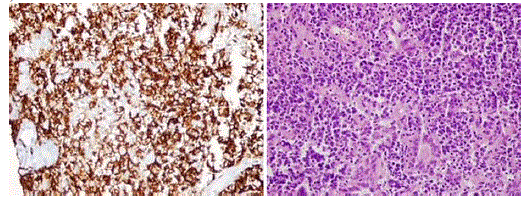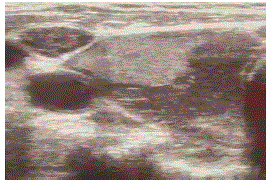ECE2023 Eposter Presentations Thyroid (128 abstracts)
A patient with thyroid lymphoma diagnosed during follow-up with benign thyroid nodule
Cigdem Birinci , Hülya Coskun , Özge Ücüncü , Cüneyt Bilginer , Özlem Kanburoglu Meletli , Mustafa Kocak & Irfan Nuhoglu
Karadeniz Technical Univercity Faculty of Medicine, Endocrinology and Metabolism, Trabzon, Turkey
Objectives: Primary thyroid lymphoma constitutes 0.5-5% of all thyroid malignancies. Its incidence is two per million persons. Patients usually present with rapidly growing masses in the thyroid their sixth-seventh decades. The disease is frequently accompanied by chronic Hashimoto’s thyroiditis. Most tumors are B-cell derived non-Hodgkin’s lymphoma.
Case report: An 84-year-old male patient presented with a palpable swelling in the neck. Ultrasonography revealed heterogeneous hypoechoic thyroid parenchyma (thyroiditis?), a 17x7 mm hyperechoic solid nodule in the right thyroid lobe, 22x9 mm lymph nodes in the right jigular chain. Thyroid antibodies were positive and laboratory tests revealed that the patient was euthyroid. Thyroid fine needle aspiration(FNA) biopsy was performed. The right lobe nodule and lymph node were found to be benign. The patient, who was followed up with benign troid nodule, presented again 6 months later with complaints of rapidly growing mass in the neck, shortness of breath, 10 kg weight loss in the last 1 month and fever. Ultrasonography revealed hypoechoic lesions diffusely infiltrating the parenchyma. Hyperechoic patchy areas and echogenic septa were observed in both lobes except infiltrating areas. Lymphadenopathies of 11x13 mm in the right cervical region and 12x6 mm in the left cervical region were observed. A core needle biopsy (CNB) was performed for definitive diagnosis of suspicious lymph node and thyroid gland and reported as compatible with disseminated large B-cell lymphoma.
Patology:

Ultrasound:

Discussion: Thyroid lymphomas are an exceptional finding in patients with thyroid nodules. Given the rarity of this disease, making a prompt diagnosis can be challenging. For instance, FNA cytology, which is the first-line diagnostic test that is performed in patients with thyroid nodules, is often not diagnostic in cases of thyroid lymphomas, with subsequent delay of the start of therapy as occured in our patient. It has been argued that in cases suspicious of thyroid lymphomas, CNB could help to reduce diagnostic surgery and, most importantly, to obtain earlier the diagnosis necessary to start life-saving treatment with multiagent chemotherapy.
Conclusions: We presented this case because it suggests that thyroid FNA biopsy, which is the most commonly used method for troid nodule evaluation, may be insufficient in the diagnosis of thyroid lymphoma. Even if the fine needle aspiration biopsy result is benign, patients should be closely monitored and should be evaluated by CNB or open biopsy when there is high clinical suspicion of malignancy.





